Laos
Things to DO
Phonsavan
Xieng Khuang Province is marked by contrasts, cultural and geographical. In the centre, broad ochre hills, laid bare
from logging and slash and burn agriculture, coat the semi flat terrain. Ordely farms intersperse the brown hues, and
eucalypts and pine plantations invoke antipodeans impressions.
As the province streches north it finds the bas of mountainous ascent, and one is struck by the beauty of high green mountains,
rugged karst formations and verdant valleys.
But when looking more closely, you notice how much of the province is pockmarked with bomb craters in which little or no
vegetation grows. By the end of the 1960s this major battlefield was undergoing almost daily bombing by American planes, as well as ground
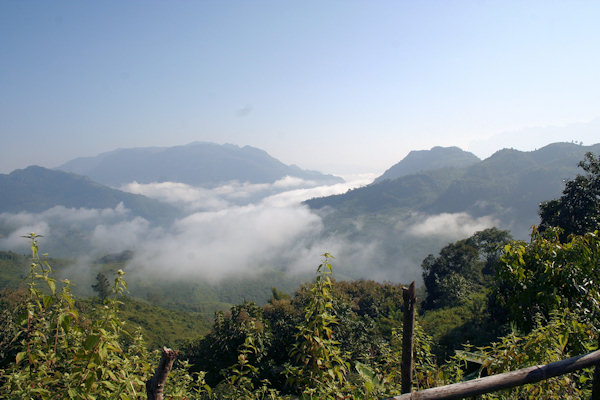 |
|||||
combat between the US trained and supplied Hmong army and the forces of the North Vietnamese and Pathet
Lao.
Due to this "secret war" - lead by US Air Force and the CIA - virtually the entire population was forced
to live in caves; The bombs fell like a man sowing seed according to one surviving villager.
Now the province is peaceful, village life has returned to a semblance of normality, although the enourmous ammount of war debris
and UXO (=Unexploded munitions) spread across, are a deadly legacy that will remain her for generations to come.
Today about 40% of the estimated 30-60 casualties per year are children, who continu to play with found UXO - especially the
harmless-looking, ball-shaped "Bomb Light Unit's" (BLO's or Bombies) left behind by cluster bombs.
In spite off that War-junk have become an important part of the local architecture and economy. Aluminium spoons, made of detonators,
and torpedo-shaped bomb casings are sold on local markets.
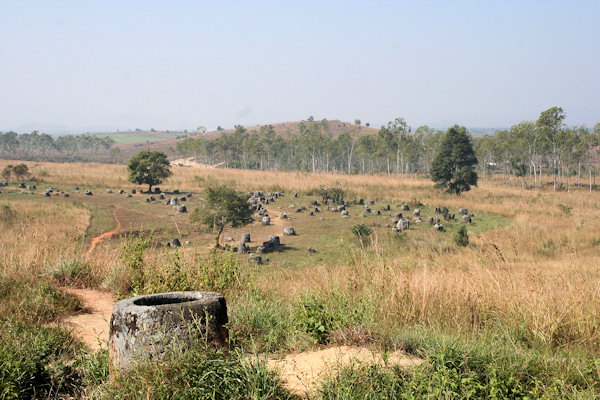 |
|||||
The Plain of Jars is a large area extending around Phonsavan, where huge jars of unknown origin are scattered about in
over a dozen groupings. Apparently the jars were carved from solid boulders of varying sizes, which goes a long way to explain the
many different sizes and shapes.
Many of the smaller jars have been taken away by various collectors, but there are still several hundred or so on the plain in
the five major sites that are worth visiting.
Quite a few theories have been advanced as to the function of the jars - that they were used as sarcophagi, or as wine fermenters,
or for rice storage - but there is no evidence confirming one theory over the other. Laying around are the stone lids for a few
of the jars.
The jars are commonly said to be 2000 years old, but in the absence of any organic material associated with the jars; there is no
reliable way to data them.
Muang Phu Khoum
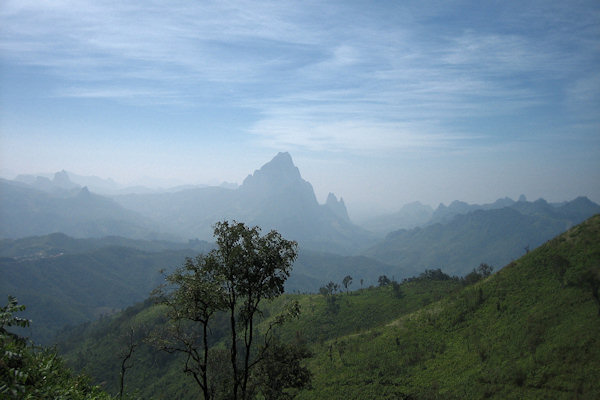 |
|||||
At the T-junction between Rte 13 north to Luang Prabang andTre 7 east to Phonsavan, lies Muang Phu Khoum,
site of a former French garrison.
Surrounded by jagged mist-shrounded mountain peaks, Muang Phu Khoum lies near the heart of the Hmong country and it was only in the
1920s, when the French extende Rte 13 this far, that it became linked to the rest of French Indochina.
During the Second Indochina War the Royal Lao Army and Pathet Lao constantly fought for control of the town,
because of its strategic location on the route to the Plan of Jars battlefields.
Other then a market, a few shops and a single guesthouse, there is little to see.
Vang Vieng
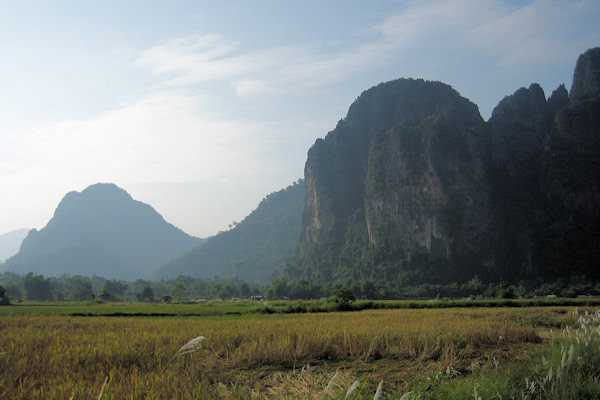 |
|||||
Nestled beside the Nam Song - River, Vang Vieng's main attraction has always been the stunning beautiful limestone
karst terrain.
Honeycombed with unexplored tunnels and caverns, these limestone cliffs are a spelunker's heaven. Several caves are named and
play minor roles in local mythology - all are said to be inhabited by spirits.
These caves and cliffs have also earned a reputation for some of the best rock-climbing in the region.
The Nam Song meanwhile, plays host to kayakers and travellers floating along on tractor inner tubes - a pastime so thoroughly
enjoyable and popular that it has become one of the rites of passage of Indochina backpacking circuit.
Other activities include rafting, trekking and bicycle and moterbike trips.
Or you could just find a riverside seat for one of the regular postcard sunsets when, if you're lucky, you might see thousands
of bats pouring forth from the karst like an oil slick flooding the skyline.
Vientiane
Set on a bend in the Mekong river, Vientiane was first settled around the 9th century AD and formed part of one of
the early Lao valley "meuang" (city-states) that was consolidated around the 10th century.
The height of Vientiane's success was probably in the years after it became the Lan Xang capital in the mid-16th century.
Several of Vientiane's wats were built then and the city became a major centre of Buddhist learning.
"It didn't last"
Periodic invasions by the Burmese, Siamese and Chinese took their toll on the city, and after a defeat in 1828
the Siamese wasted in no time the city and the city was abandoned.
In 1867, French Explorers arrived but it wasn't until late in the century, after Vientiane had been made capital of the French
protectorate, that serious reconstruction began. A simple grid plan was laid out for the city and a sprinkling of colonial-style
mansions and administrative buildings emerged.
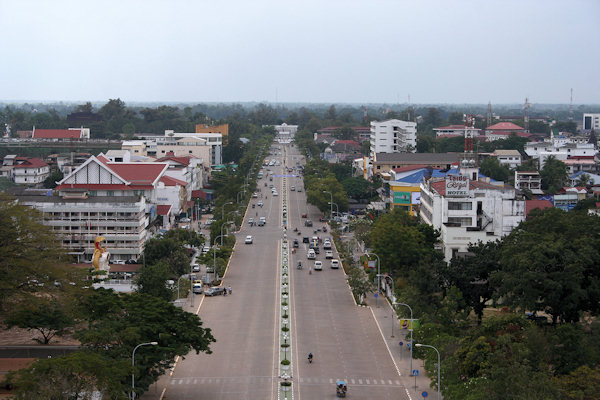 |
|||||
However, Vientiane was always low in the French order of Indochinese priorities, as the modern building program testifies.
Patuxai
Reminiscent of the Arc de triomphe in Paris, the Patuxai is Vientiane's most prominent monument.
It was built in the 1960s with US-purchased cement that was supposed to have been used for th construction of a new airport.
Hence it's sometimes called "The vertical Runway".
That Dam
Sitting at the centre of a quiet roundabout near the centre of Vientiane, legend has it that the stupa known as That Dam was
once coated in a layer of gold.
The gold is said to have been carted off by the Siamese during their pillaging of 1828, after which the stupa took the black
sobriquet in memory of the dastardly act.
The stupa appears to date from the Lan Xang period.
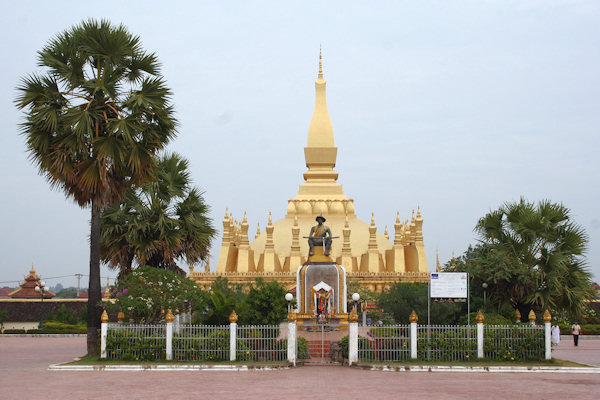 |
|||||
Pha That Luang
The most important national monument in Laos Pha That Luang is a symbol of both the Buddhist religion and Laos sovereignty. Its
full official name, Pha Chedi Lokajulamani, means "World-Precious Sacred Stupa", and an image of the main stupa appears
on the national seal and in countless other places.
Legend has it that Ashokan missionaries from India erected a "Thâat" or reliquary stupa here to enclose a piece of the Buddha's
breastbone as early as the 3rd century BC.
When King Setthathirat moved the Lan Xang capital from Luang Prabang to Vientiane in the mid-16th century, he ordered the construction
of Pha That Luang in its current form on the site of the old Kmer temple.
Construction began in AD 1566 and in succeeding years four wats were built around the stupa, one on each side. (only two remain today).
Unfortunately, the glory of the Lan Xang-kingdom was only to last till the end off the 17th century.
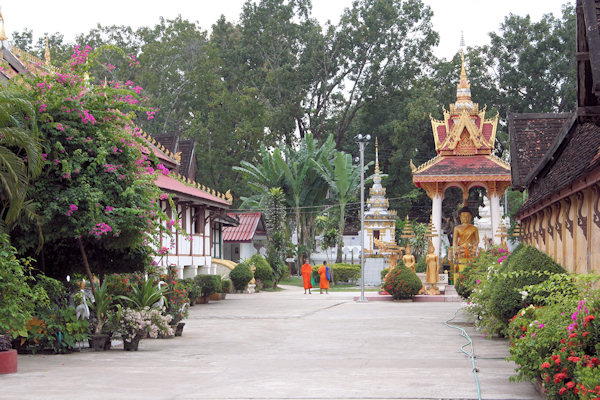 |
|||||
Wat Si Saket
Built between 1819 and 1824 by Chao Anouvong this wat is believe to be Vientiane's oldest surviving temple.
Chao Anou, who was educated in the Bangkok court and was more or less a "vassal" of the Siamese state, had Wat Si Saket
constructed in the early Bangkok style but surrounded it with a thick-walled cloister.
The stylistic similarity to their own wats might have motivated the Siamese to spare this monastery when they crushed Chao Anou's
rebellion, even as they razed many others. The French restored the temple in 192 and again in 1930.
The interior walls of the cloister are riddled with small niches that contain over 2.000 silver and ceramic Buddha images. Over 300
seated and standing Buddhas of varying sizes and materials (wood, stone, silver, bronze) rest on long shelves below the niches
most of them sculpted or cast in the characteristic Lao style.
The "sim" is surrounded by a colonnaded terrace in bangkok style and topped by a five-tiered roof.
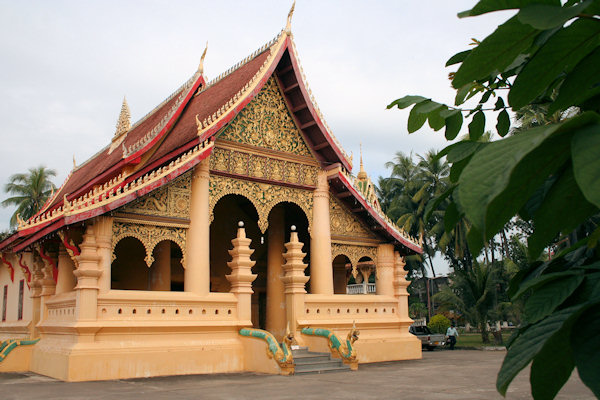 |
|||||
Wat Ong Teu Mahawihan
This temple is one of the most important in Lao.
It was originally built in the mid-16th century by King Setthathirat and is believed to occupy a site first used for religious
purpose as far back as the 3rd century.
But like almost every other temple in Vientiane it was destroyed in later wars with the Siamese, then rebuilt in the early 20th
century.
The Hwang Sangkhalat ("Deputy Patriarch") of the Lao monastic order has his official residence here and presides over
the Buddhist Institute, a school for monks who come from all over the country to study "dhamma" (the Buddha's teachings).
The temple's namesake is a 16th-century bronze Buddha, measuring 5.8m tall and weighing several tonnes, that sits in the rear of
the "sim", flanked by two standing Buddhas.
This "sim" is famous for the wooden facade over the front terrace, a masterpiece of Lao carving.
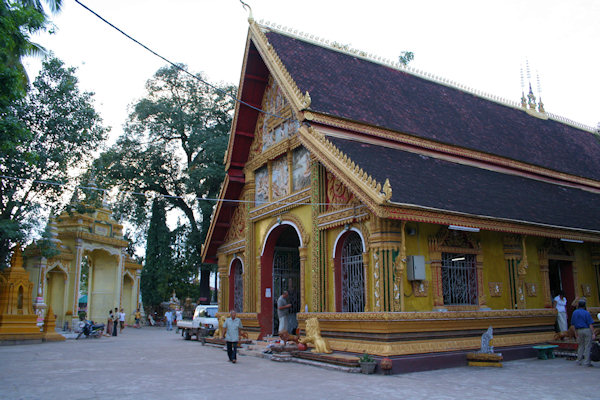 |
|||||
Wat Si Muang
The most frequently used grounds in Vientiane are those of Wat Si Muang, the site of the "lák meuang" (city pillar/phallus),
which is considered the home of the guardian spirit of Vientiane.
The "sim" (destroyed in 1828 and rebuilt in 1915) was constructed around the "lák meuang", which forms the centre of
the altar.
The pillar itself is believed to date from the Kmer period, indicating the site has been used for religious purpose for
more than 1.000 years. Today it is wrapped in sacred cloth, and in front of it is a carved wooden stele with a seated Buddha in relief.
Several other Buddha images surround the pillar, including one partially damaged image that sits on a cushion. This rather melted-looking
seated stone Buddha survived the 1828 inferno and locals believe it has the power to grant wishes or answer troubling questions.
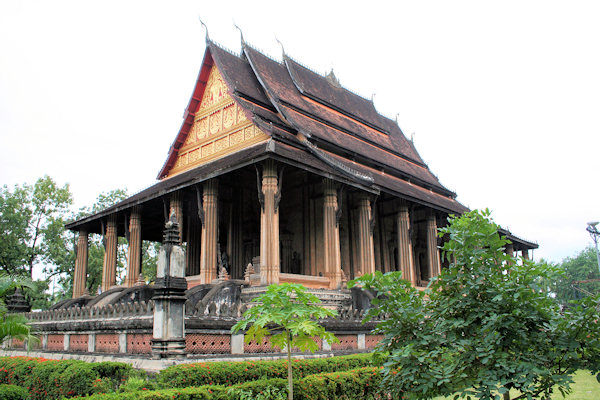 |
|||||
Haw Pha Kaeo
According to the Lao, the temple was originally built in 1565 by command of King Setthathirat, wo brought the so-called
"Emerald Buddha" (Pha Kaeo" in Lao) with him from Luang Prabang. What Pha Kaeo also served as Setthathirat's
personal place of worship.
Following a skirmish with the Lao in 1779, the Siamese stole the Emerald Buddha and installed it in Bankok's Wat Phra Kaew.
Later, during the Siamese-Lao war of 1828, Vientiane's Wat Pha Kaeo was razed.
The temple was finally rebuilt with French help between 1936 and 1942, supposedly following the original plan exact.
Wat Sok Pa Luang
In a shaded, almost semirural setting that is entirely in keeping with its name ("wat paa" means 'forest temple'),
Wat Sok Pa Luang is famous for its herbal saunas and expert massage.
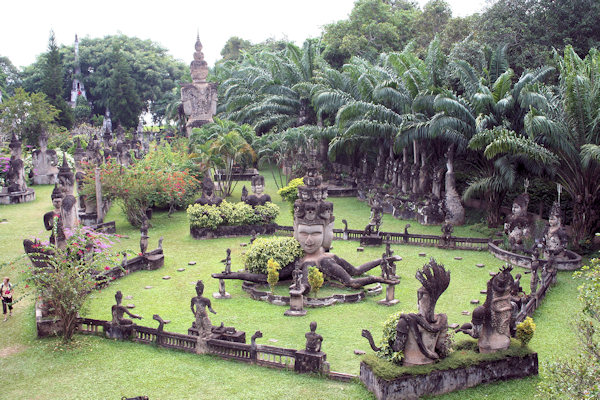 |
|||||
Xieng Khuan
In a field by the Mekong River about 24 km south of central Vientiane, Xieng Khuan is a park full of Buddhist and Hindu
sculpture that is a monument to one eccentric man's quite bizarre ambition.
Xieng Khuan was designed and built in 1958 by "Luang Pu" (Venerable Grandfather) Bunleua Sulilat, a
yogi-priest-shaman who merged Hindu and Buddhist philosophy, mythology and iconography into a cryptic whole.
Originally, Bunleua is supposed to have studied under a Hindu "rishi" (sage) who lived in Vietnam. Bunleua developed
a large fellowing in Laos and northeastern Thailand, and moved to Thailand around the time of the 1975 Revolution.
The concrete sculptures at Xieng Khuan (wich means "Spirit City") are bizarre but compelling in their naive confidence. They
include statues of Shiva, Vishnu, Arjuna, Avalokiteshvara, Buddha and numerous other deities.
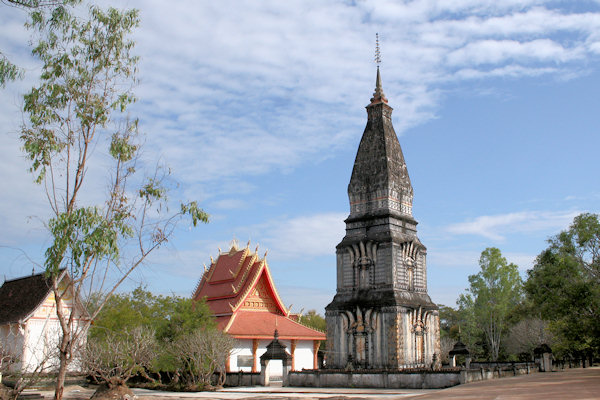 |
|||||
Wat Pha Baht Phonsan
South of the Ban Na- village, which is about 82 km northeast of Vientianne lies Wat Pha Baht Phonsan.
The wat is revered for its large "pha bàat" (Buddha footprint), shrine, moastery and substantial reclining Buddha figure.
You'll know it by the large and well-oramented 1933-vintage stupa.